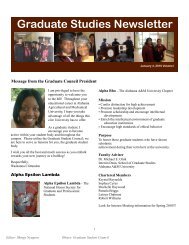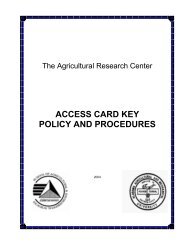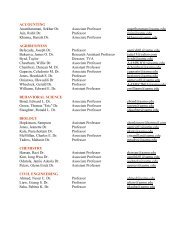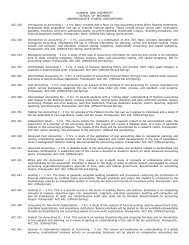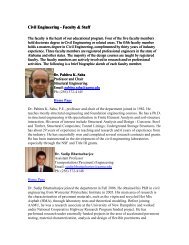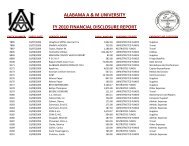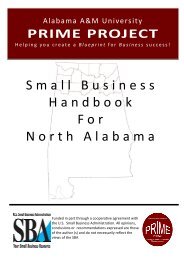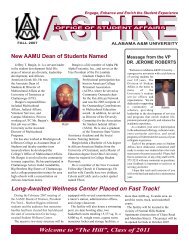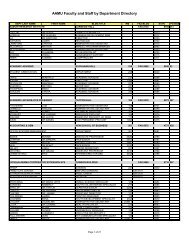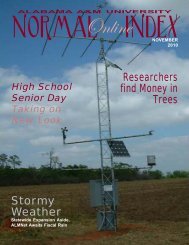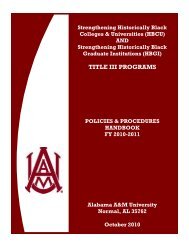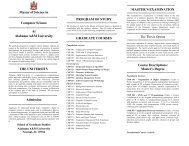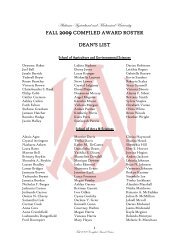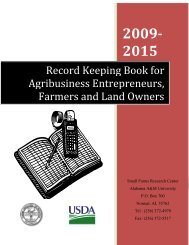Small Farms Research Center Brochure - Welcome to Alabama ...
Small Farms Research Center Brochure - Welcome to Alabama ...
Small Farms Research Center Brochure - Welcome to Alabama ...
Create successful ePaper yourself
Turn your PDF publications into a flip-book with our unique Google optimized e-Paper software.
Key Functions of the <strong>Small</strong> <strong>Farms</strong> <strong>Research</strong> <strong>Center</strong>The <strong>Center</strong> is an integral part of the Department of Agribusiness withinthe School of Agricultural and Environmental Sciences. It is housed in215 James I. Dawson Cooperative Extension Building on AAMU campus.It caters and responds directly <strong>to</strong> the needs of small and limited resourcefarmers/ranchers, researchers, organizations, agribusiness specialists,extension agents and consumers by providing research results,publications, outreach and technical assistance, and educational programson small farms <strong>to</strong>pics. The outreach <strong>Center</strong> is multi-faceted, withincreasingly diverse functions including, but not limited <strong>to</strong>, the following:Serving as a clearinghouse for questions from small and limitedresource farmers, ranchers, landowners, agribusiness managementspecialists, extension personnel, government officials and agencies,and the academic community;Conducting socio-economic research and evaluating issues andfac<strong>to</strong>rs that directly or indirectly impact the profitability of limitedresource farms or ranches, enhance economic development, andpromote viability and overall sustainability of local communities;<strong>Alabama</strong> A&M University4900 Meridian StreetJames I. Dawson Building, Room #215Normal, AL 35762Publishing research findings, manuals, fact sheets, proceedings,pamphlets, leaflets, and a quarterly newsletter that include news ofupcoming events, publications, <strong>to</strong>pical issues, and profiles ofoutstanding and exemplary small farmers or ranchers, extensionpersonnel and key local community leaders;Sponsoring workshops and conferences, conducting, distributing,and promoting information about on-farm research, sustainablepractices, and marketing strategies for small farmers and ranchers;Organizing farm- or ranch-based events and learning opportunitiesthat promote, empower and educate local farmers, ranchers andcommunity members;Fostering connections between area farmers, ranchers, landownersand community members that establish and promote communicationabout local agricultural concerns;Organizing and coordinating local, regional, national and statewideconferences, meetings, training workshops, and symposiums;Supporting extension personnel, farm and agribusiness managementspecialists, women, rural youth, farmers markets and farm or ranchorganizations in national, regional and local programs;Providing opportunity for local small and limited resource farmers<strong>to</strong> socially, educationally and philosophically interact; andProviding leadership and coordination for all sponsored and nonsponsoredprojects within the <strong>Center</strong>.<strong>Small</strong> <strong>Farms</strong> <strong>Research</strong> <strong>Center</strong>ALABAMA A&M UNIVERSITY4900 Meridian StreetP.O. Box 700Normal, <strong>Alabama</strong> 35762-0700Tel: 1-866-858-4970Fax: 1-256-372-5517Dedicated <strong>to</strong> Preserving Minority Land, Protecting <strong>Small</strong> <strong>Farms</strong>,Promoting Entrepreneurship, and Sustaining Rural BusinessesWe are on the Web!http://www.aamu.edu/smallfarmers/Dr. Duncan M. Chembezi, Direc<strong>to</strong>rMs. E’licia L. Chaverest, Program Manager & Marketing Specialist
ABOUT THE CENTERThe concept of a <strong>Small</strong> <strong>Farms</strong> <strong>Research</strong> <strong>Center</strong> at <strong>Alabama</strong> A&MUniversity (AAMU) was first conceived in 2000 with funding fromUSDA’s Office of Outreach authorized under Section 2501 of the 1990Farm Bill. The <strong>Center</strong> is devoted <strong>to</strong> issues affecting the family farm, andassessing how such issues impact profitability and overall sustainabilityof small farm operations. AAMU’s 2501 project (a.k.a. <strong>Small</strong> Farmers’Outreach Training and Technical Assistance Project) received its initialfunding in 1994. The project’s goal at that time was narrow, andrestricted primarily <strong>to</strong> the provision of outreach training and technicalassistance in areas of record keeping, loan application, and delivery ofproduction, marketing and financial information <strong>to</strong> farmers and ranchersrarely reached by the traditional extension machinery. The clientele inthis category usually operate small-scale, family-owned or familymanagedfarms, often with limited resources.As project staff and faculty grew in numbers and became diverse, andactivities more complex and holistic in nature, the need for a <strong>Center</strong> <strong>to</strong>conduct sound and targeted research, provide quality education andeffectively deliver outreach training <strong>to</strong> minority and underservedagricultural producers, became increasingly inevitable. Thus, the <strong>Small</strong><strong>Farms</strong> <strong>Research</strong> <strong>Center</strong> was initiated in 2000 <strong>to</strong> conduct research andprovide outreach services throughout the State of <strong>Alabama</strong>, with specialand particular emphasis on 21 underserved counties in north <strong>Alabama</strong>.All the functions within the <strong>Small</strong> <strong>Farms</strong> <strong>Research</strong> <strong>Center</strong> operate in thecontext of seven distinct units or divisions: (a) <strong>Research</strong> and PolicyAnalysis Unit, (b) Risk Management Education and CommunityOutreach Unit, (c) Rural Business Development and EntrepreneurialOutreach Initiative, (d) Agricultural Biotechnology and Food SafetyEducation, (e) Technology (Computer Training) Outreach <strong>Center</strong>, (f)Youth Entrepreneurship Program (YEP), and (g) Women-In-Agriculture(WIA) Program. Even though all the units function <strong>to</strong>gether as one unit,each of these units has separately been funded. Since 1996, over $9.63million in grants and agreements has been invested in the operation ofresearch and outreach programs at <strong>Alabama</strong> A&M University. Theoverall goal has been <strong>to</strong> conduct outreach training and provide technicalassistance and advice <strong>to</strong> minorities and underserved producers, landowners, businesses and entrepreneurs throughout the state of <strong>Alabama</strong>. <strong>Research</strong> & Agricultural Policy Analysis Unit: An agricultural policy analysiscapability exists within the <strong>Center</strong> whose function it is <strong>to</strong> examine the impacts ofalternative policy changes on state agricultural economy. The modeling system isfunded by USDA-CSREES, and it comprises an econometric model, an impactanalysis policy simulation model (IMPLAN), a farm-level policy analysissimulation model (FLIPSIM) and an environmental impact simulation model(EPIC). These models are interactively used <strong>to</strong> simulate the impacts of changes in apolicy or market conditions on different sec<strong>to</strong>rs of the state’s agricultural economy.This information is used for policy decisions and evaluation. The information is alsoshared with farmers and ranchers and entrepreneurs <strong>to</strong> allow them better managetheir farms and business operations. In summary, this unit acts in a supportive role<strong>to</strong> all the other units. Through fact sheets, flyers and other research publications, itprovides research-based information <strong>to</strong> producers and entrepreneurs. Risk Management and Community Outreach Program: This component ofthe <strong>Center</strong>’s outreach program is funded by USDA-CSREES and USDA-RiskManagement Agency. Our efforts involve effective delivery of community outreachtraining, conducting educationalgroup meetings, seminars andworkshops, and field days, andproviding technical assistance andrisk management education <strong>to</strong> allproducers in the state of <strong>Alabama</strong>with a special focus on minorities,small and socially disadvantagedagricultural producers and landowners. The outreach or extensionefforts target specific priorityareas which maximize theprogram’s benefits per unit dollarinvested. The operation of theoutreach/extension programs isbased on a new synergy derivedfrom mutually beneficial partnerships that have so far evolved over time. Theoutreach and risk management program blends unique approaches <strong>to</strong> outreach,develops training materials and resources, and identifies key strategies <strong>to</strong> managerisk, enhance farm profitability and promote overall sustainability. Rural Business Development and Entrepreneurial Outreach Initiative: Thisportion of the <strong>Center</strong>’s outreach or extension activities is funded by USDA-RuralDevelopment through a cooperative and/orpartnership agreement. The <strong>Center</strong>’s zeal anddesire <strong>to</strong> initiate a business or agribusinessdevelopment and entrepreneurial outreachinitiative arose out of the realization that<strong>Alabama</strong> is a classic example of the nation’smost rural states and economic restructuringacross the nation has affected it in ways thatare significantly different from theexperiences of other rural regions of theUnited States. The state’s economy continues<strong>to</strong> lag behind national averages on mosteconomic measures. <strong>Research</strong> points out thespecial needs of small businesses in mostrural areas: (1) few small rural entrepreneurshave a good objective picture of the financialcondition of their businesses; (2) the managerial sophistication of small ruralbusiness people varies considerably among firms; and (3) there is a critical need <strong>to</strong>develop a financial management information system that is relevant <strong>to</strong> smallbusinesses and useful for outreach training. The pool of business skills (includingmanagement, finance, and marketing) among small rural business entrepreneurs isclearly expandable through educational programs. Furthermore, the incidence andsuccess of entrepreneurial activities could also be influenced through appropriateoutreach and/or cooperative extension programs. Agricultural Biotechnology and Food Safety Education Program: Themajor focus in this area is educating farmers, ranchers, consumers and thegeneral public about food-borne illnesses anddiseases and how these illnesses can beprevented. One grant from USDA-CSREESand a cooperative agreement from USDA-FoodSafety Inspection Service have been used <strong>to</strong>provide food safety education <strong>to</strong> underservedcommunities in <strong>Alabama</strong>. The goal is <strong>to</strong> havean informed society about food safety issues. A<strong>to</strong>tal of over $267,000, over three years, hasbeen invested and used in this portion ofeducational, outreach programs and technicalassistance programs at <strong>Alabama</strong> A&MUniversity. One important truth or fact fromthese outreach or educational activities is thatthe public is hungry for knowledge and iscraving for information about food safety and other issues including thesafety of genetically modified food products. Technology (Computer Training) Outreach <strong>Center</strong>: This is an area thatis currently being pursued vigorously. The aim is <strong>to</strong> educate producers aboutthe use of technology or computers for record keeping, financial analysis andonline trading. One useful approach that has yielded limited but remarkablesuccess is the inter-generational computer use or technology training. Itinvolves the old and the young working <strong>to</strong>gether on how <strong>to</strong> use computers ortechnology. Young adults are able <strong>to</strong> teach older folks how <strong>to</strong> use computers.At the same time, young folks are able <strong>to</strong> learn the art of farming from olderfolks. Sweet successes have been achieved and the <strong>Small</strong> <strong>Farms</strong> <strong>Research</strong><strong>Center</strong> continues <strong>to</strong> invest in this approach for many of the producers in<strong>Alabama</strong> who have expressed the need and/or interest. Youth Entrepreneurship Program (YEP):This program provides entrepreneurial training,financial literacy, business and life skills <strong>to</strong>underserved youth by making technology andother resources available <strong>to</strong> them (especiallyteens and tweens). Statistics show that a highnumber of youth in underserved communitiesfail <strong>to</strong> develop academic, social and citizenshipskills necessary <strong>to</strong> compete and/or succeed in<strong>to</strong>day’s society. This entrepreneurship programoffers the youth the needed or necessarysurvival skills, and prepares them <strong>to</strong> have aproductive future and rewarding careers. <strong>Alabama</strong> Women –In– Agriculture (AWIA) Program: This programhas been developed <strong>to</strong> empower women through education, involvement,and action. The program seeks <strong>to</strong> promote educational and training programsin order <strong>to</strong> develop the interest of women in agriculture and <strong>to</strong> promoteagriculture in <strong>Alabama</strong>.Specifically, AWIAs missionis <strong>to</strong> (i) promote agriculture in<strong>Alabama</strong>; (ii) speak on behalfof agriculture in an intelligent,informative, direct and truthfulmanner; (iii) keep programme mbers informed onlegislative activities pertaining<strong>to</strong> agriculture; (iv) join forceswhen the need arises <strong>to</strong> dealwith agricultural problems in a specific community; and (v) improve thepublic image of farmers and ranchers; and (vi) network, connect and developrapport within and among agricultural communities throughout the state.



